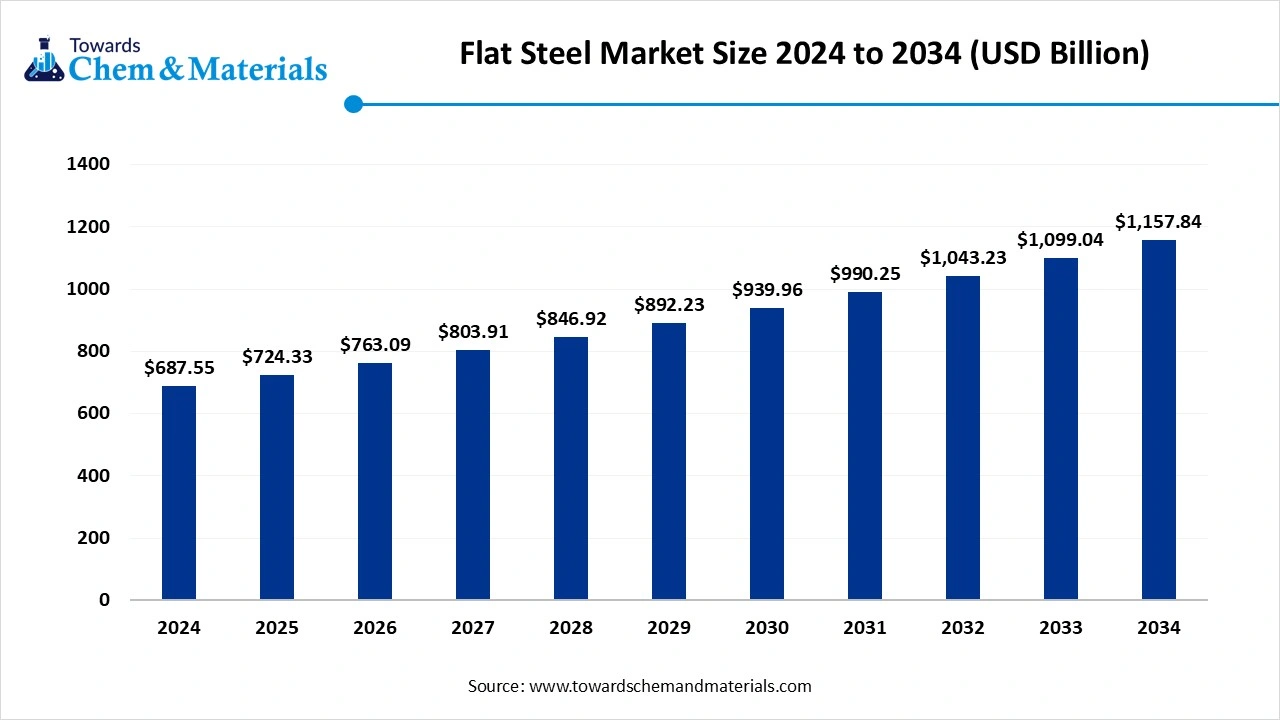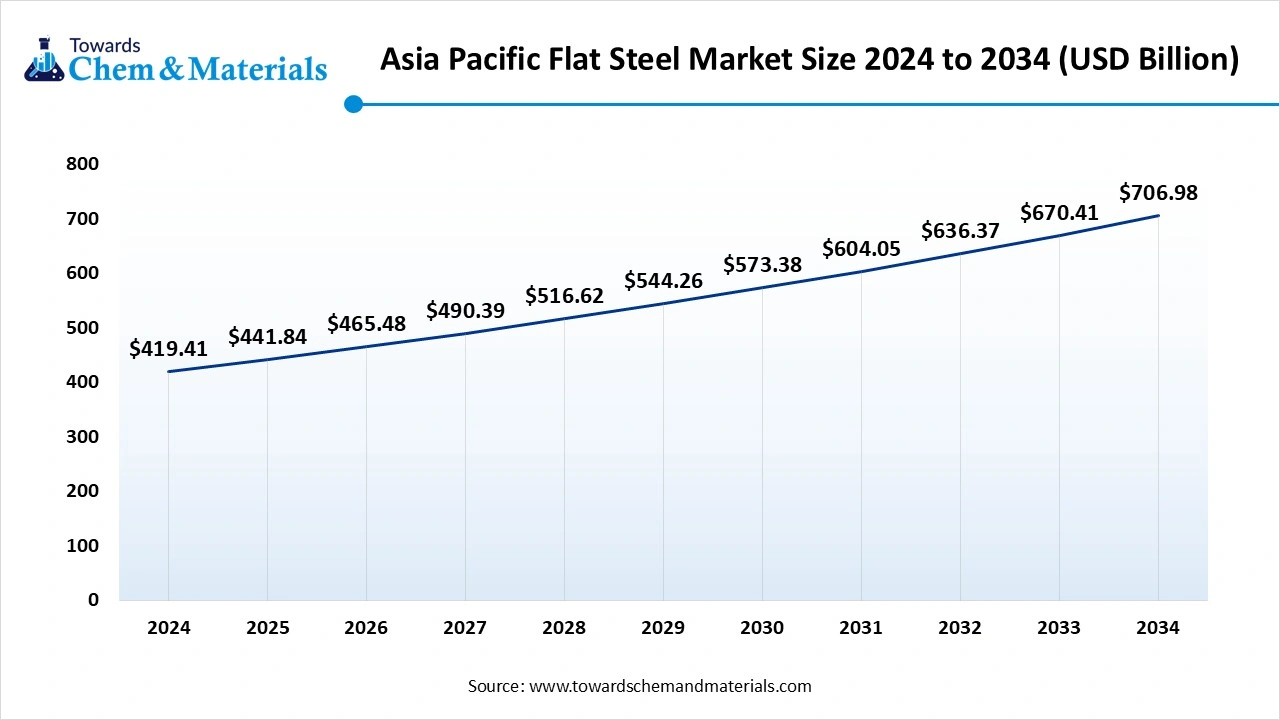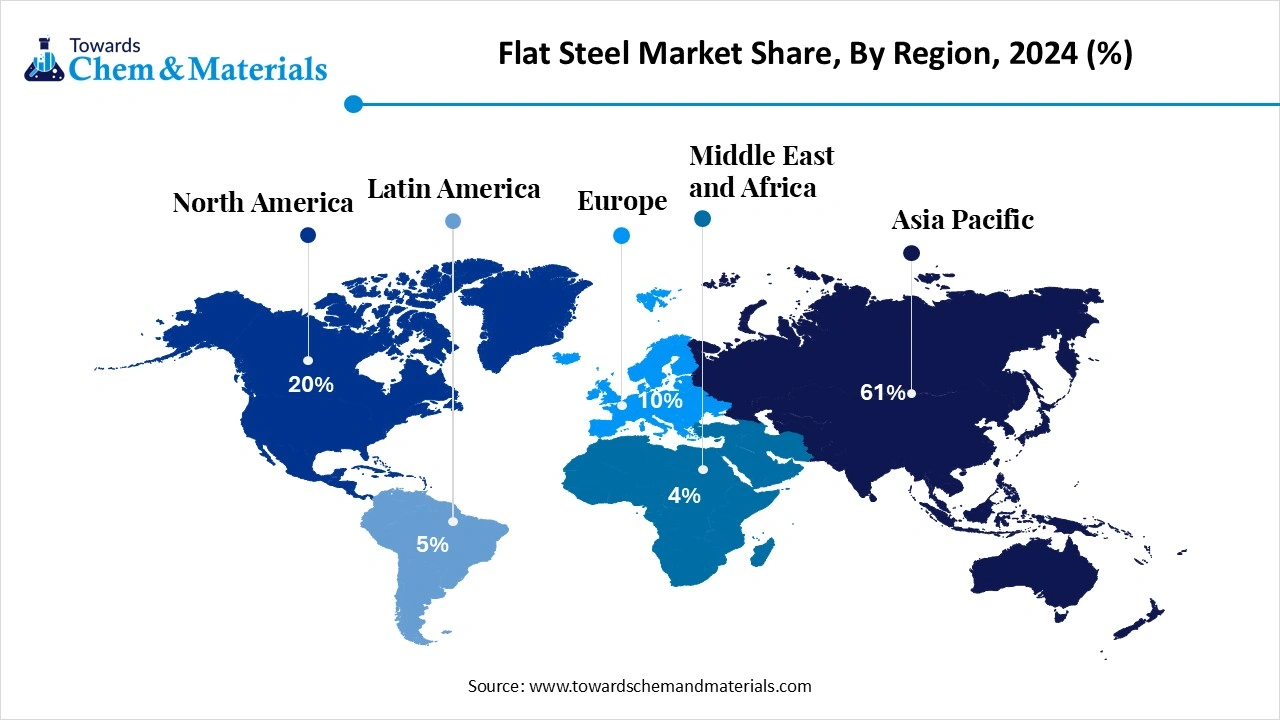November 2025
The flat steel market size accounted for USD 687.55 billion in 2024 and is predicted to increase from USD 724.33 billion in 2025 to approximately USD 1,157.84 billion by 2034, expanding at a CAGR of 5.35% from 2025 to 2034. The rapid urbanization and infrastructure development are the key factors driving market growth. Also, ongoing advancements in steel production processes, coupled with the growing private and government investment, can fuel market growth further.

The adoption of new manufacturing processes is enhancing overall market efficiency and propelling market growth. Flat steel is the steel that has been transformed into flat, strip, coils, or rectangular sheets through a rolling process that minimizes its thickness and shapes it.
It is a crucial category of steel products, along with products such as rails and beams, and comes in various forms, such as cold-rolled steel, hot-rolled steel and other types of coated steel. These products are essential in many sectors, from automobile and home appliance production.
| Report Attributes | Details |
| Market Size in 2025 | USD 724.33 Billion |
| Expected Size by 2034 | USD 1,157.84 Billion |
| Growth Rate from 2025 to 2034 | CAGR 5.35% |
| Base Year of Estimation | 2024 |
| Forecast Period | 2025 - 2034 |
| Dominant Region | Asia Pacific |
| Segment Covered | Product Type, Material Type, Manufacturing Process, End-Use Industry, By Region |
| Key Companies Profiled | China Baowu Steel Group, JFE Steel Corporation, HBIS Group, Thyssenkrupp Steel, Voestalpine AG, United States Steel Corporation, Steel Dynamics, Inc., Nucor Corporation, SSAB AB, Gerdau S.A., JSW Steel, Hyundai Steel, Ansteel Group Shougang Group, Severstal, Essar Steel |
Key technological shifts in the market are emphasized on development of advanced materials, decarbonization efforts, and extensive digitalization to fuel efficiency and quality. Moreover, these changes address the rising demand for superior product performance and sustainability from the automotive, construction, and renewable energy sectors.
Companies such as Nippon Steel and POSCO are developing hydrogen-based steelmaking processes to minimize CO2 emissions. Nippon Steel provides certified green steel products that utilize mass balance methodology to reduce the CO2 emission by fulfilling demand from sectors such as automotive.
The growing trend towards nuclearization among the population, along with the rapid urbanisation, is a major factor creating lucrative opportunities in the market. The construction sector uses flat steel for structural support and construction frames in roofing, staircases, and shed applications.
Furthermore, the construction projects like skyscrapers and steel bridges necessitate a substantial amount of steel plates.
Tariffs and other trade challenges can disrupt the global market by creating uncertainty, which is the major factor hindering market growth. Moreover, labor shortages, logistics hurdles, and geopolitical events can affect the flow and availability of raw materials and finished products, leading to market hindrance further.
| Country/Region | Key Regulations |
| India | In August 2025, India finalized a three-year safeguard measure on certain flat steel products. It includes a staggered import duty of 12% in the first year, 11.5% in the second, and 11% in the third. |
| European Union (EU) | As of March 2025, the EU is implementing stricter rules to prevent the circumvention of tariffs. This rule dictates that the origin of a steel product is determined by where it was melted, rather than its final processing location. |
| China | In February 2025, China released new guidelines to move its steel industry toward higher quality and sustainable development. |
Which Product Type Segment Dominated the Flat Steel Market in 2024?
The plates segment dominated the market with a 66% share in 2024. The dominance of the segment can be attributed to the rapid infrastructure development and rising urbanisation, especially in emerging economies such as China and India. Additionally, the steel sector is experiencing innovations in technology, such as advanced alloys and processing methods, which are specific to various needs across several sectors.
The coated steel segment is expected to grow at the fastest CAGR over the forecast period. The growth of the segment can be credited to the rapid technological innovations in steel production and applications, along with the increasing emphasis on sustainable practices. Also, the automotive sector is a major consumer of flat steel, and expansion in this sector directly contributes to growth in the coated steel segment.
How Much Share Did the Carbon Steel Segment Held in 2024?
The carbon steel segment held a 70% market share in 2024. The dominance of the segment can be linked to the expanding infrastructure and construction sector, particularly in developing economies, coupled with the rapid development of energy projects. In addition, carbon steel's high durability, strength, and relatively low cost compared to other materials can drive segment growth soon.
The stainless-steel segment is expected to grow at the fastest CAGR over the forecast period. The growth of the segment can be driven by a surge in automotive production and increasing product demand from the construction sector. Furthermore, advancements in steel production and processing make flat steel more lightweight, reliable, and versatile, expanding its applications across different sectors.
Which Manufacturing Process Segment Dominated the Flat Steel Market in 2024?
The basic oxygen furnace (BOF) segment dominated the market with a 60% share in 2024. The dominance of the segment is owed to the growing product demand from automotive, construction, and mechanical equipment. This manufacturing process uses oxygen to oxidize impurities, which is an exothermic reaction that smoothly melts big iron and scrap into steel.
The electric arc furnace (EAF) segment is expected to grow at the fastest CAGR over the projected period. The growth of the segment is due to the ongoing transition towards electric-based steelmaking, especially in developed regions such as Europe and North America. Moreover, EAFs depend heavily on scrap metal, which makes them central to the circular economy by improving their growth prospects.
How Much Share Did the Building & Construction Segment Held in 2024?
The building & construction segment dominated the market with an 80% share in 2024. The dominance of the segment can be attributed to the rapid infrastructure development and urbanization, boosted by population growth along with the growing middle-class affluence. Also, the construction sector's growing emphasis on sustainable building materials fuels the demand for flat steel products.
The automotive & aerospace segment is expected to grow at the fastest CAGR over the study period. The growth of the segment can be credited to the growing demand for high-strength and lightweight materials to enhance overall fuel efficiency and performance in both sectors. Furthermore, advancements in material design and production processes are improving the efficiency and quality of flat steel production soon.
Asia Pacific Flat Steel Market Size, Industry Report 2034
The Asia Pacific flat steel market size was valued at USD 419.41 billion in 2024 and is expected to surpass around USD 706.98 billion by 2034, expanding at a compound annual growth rate (CAGR) of 5.37% over the forecast period from 2025 to 2034. Asia Pacific dominated the market with a 61% share in 2024.

The dominance of the segment can be attributed to the rapid urbanization and industrialization, which lead to increased demand from expanding automotive and construction sectors. In addition, the region also benefits from a strong industrial base, large-scale manufacturing capabilities, and established steel production infrastructure.

North America is expected to grow at the fastest CAGR over the forecast period. The growth of the region can be credited to the growing product demand from major sectors such as construction and automotive, coupled with the rapid infrastructure development projects. Furthermore, governments are increasingly investing in revitalizing and expanding infrastructure, like bridges and highways, which raises the demand for steel.
Product Type
Material Type
End-Use Industry
By Region
The global carbon steel market is projected to grow from USD 1,072.38 billion in 2025 to USD 1,802.47 billion by 2035, growing at a compound annual gr...
November 2025
November 2025
November 2025
November 2025